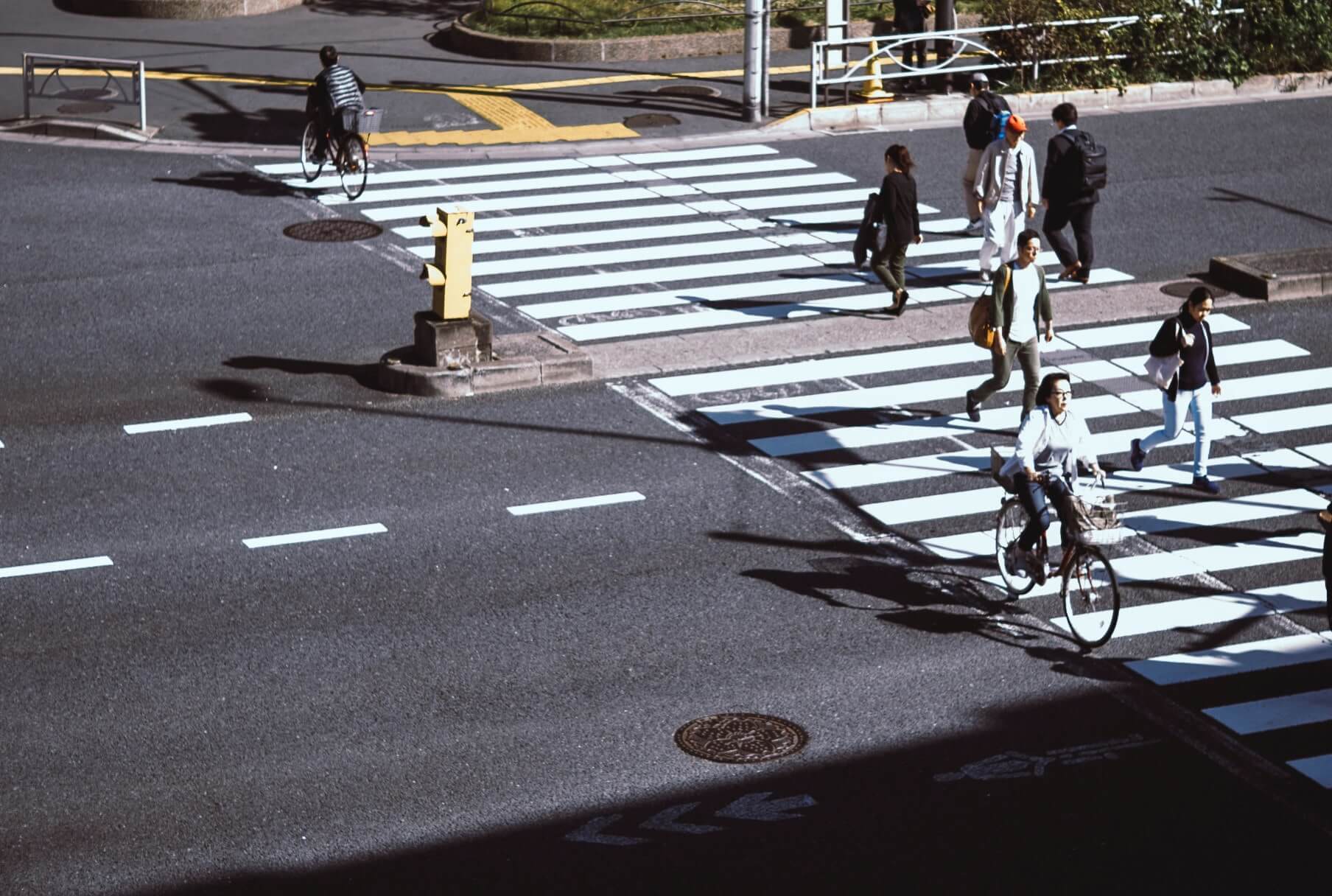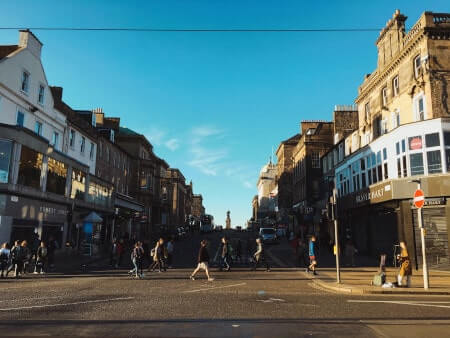
Accessibility Toolkit: When Complete Streets Help People with Disabilities
After World War II, cars’ supremacy started to shape Northern American cities. Consequently men started to be more and more dependent on their personal vehicle to move around and roads were designed to the detriment of sidewalks, mass transit and bike trails.
It was not until the early 1970s that some states like Oregon began to design the urban space with all users in mind to make transportation network safer and more efficient. This is how Complete Streets-like policy was born. Many jurisdictions have followed over the years.
Today, no less than 1,200 agencies at local, regional and state levels have adopted Complete Street policies in the United States. Depending on the jurisdiction, Complete Streets can be a non-binding resolution, incorporated into local transportation plans or a fully bidding law.
Meanwhile accessibility has never been such a strong challenge. According to recent studies, 1 adult in 4 lives with a disability which amounts to 61 million Americans (cdc.gov).
So what are Complete Streets policies and above all why do they matter for disabled people?
Complete Streets design elements
Streets are more and more congested. It can be hard for everyone to find their place, especially in city centers where pedestrians, bikes and motorized vehicles coexist.
Complete Streets policies precisely aim at enabling safe use and support mobility for all users using various street design elements such as:
⊗ Pedestrian infrastructure: sidewalks, crosswalks, median crossing islands, curb extensions, pinchpoint, Accessible pedestrian Signals for visually impaired people, pedestrian wayfinding, greenery, and street furniture.
⊗ Traffic calming measures to lower speeds of vehicles: speed humps, speed tables, speed cushions, signage, and traffic lights.
⊗ Bicycle accommodations: protected or dedicated bicycle lanes, repair stations, and bicycle parking.
⊗ Public transit equipment: Bus Rapid Transit, bus pullouts, transit signal priority, bus shelters, and dedicated bus lanes.
Incomplete streets obstacles for disabled people
Cars’ supremacy left a legacy in Northern American cities.
Car-centric roadways lead to uneven access to urban services. And it is all the more true for disabled people who most often cannot use cars. Cities that don’t offer Complete Streets measures in their busiest areas force citizens and especially disabled people to face huge challenges when getting around.
Here is a non-exhaustive list of what is causing difficulties to pedestrians with disabilities in “incomplete streets”-like designs:
⊗ Unpaved, broken, or disconnected surfaces
⊗ Lack of curb cuts and ramp
⊗ Ponding of stormwater and runoff streams near intersections
⊗ Lack of Accessible Pedestrian Signals (APS) at signalized intersections. This article goes into more details about this specific point.
⊗ Inadequate sidewalks or intersections design
⊗ Wide intersections with limited crossing time
⊗ Lack of escalators, elevators or ramps to overcome steps
⊗ Inaccessible bus stops
⊗ Large spaces without landmarks
⊗ Routes going nowhere
⊗ Inappropriate sidewalk obstacles
⊗ and the list goes on…
What benefits for disabled people?
Complete Streets design provides an environment where all street users, particularly the most vulnerable, can get around safely and efficiently. This means that regardless of the mode of transportation, the age, the ability, or the confidence level, streets are accessible, safe and appropriate for the needs of all users.
Ontario was the first Canadian state to adopt a Complete Streets policy to help disabled citizens navigate streets more efficiently. In 2017, Ontario’s Growth Plan encouraged equity by incorporating strong directives in order to build streets that meet the needs of all road users.
“In the design, refurbishment, or reconstruction of the existing and planned street network, a complete streets approach will be adopted that ensures the needs and safety of all road users are considered and appropriately accommodated.”
Moreover statistics show that pedestrian street activity increases support of local businesses and expands employment opportunities.
Streets are complete and accessible using mainly:
⊗ Tactile walking indicators;
⊗ Accessible Pedestrian Signals;
⊗ Push buttons accessible to wheelchair users;
⊗ Ramps and curb cuts
However, the legacy of years of valuing cars in Northern American society and the difficulty to change attitudes towards the most fragile people show that there is a lot of work to be done.
Considering that major american cities have less than 1% of signalized intersections equipped with Accessible Pedestrian Signals, it leaves a lot of room for improvement!
Wondering which Accessible Pedestrian Signal to choose? Use the new APS comparator!
media

Complete Streets design provides an environment where all street users, particularly the most vulnerable, can get around safely and efficiently.
This means that regardless of the mode of transportation, the age, the ability, or the confidence level, streets are accessible, safe and appropriate for the needs of all users.
writer

Zoe Gervais
Content Manager
stay updated
Get the latest news about accessibility and the Smart City.
other articles for you

Open Data Is Key to Fostering Universal Accessibility
Open data represents an opportunity for cities to reach universal accessibility. It shows the missing links of the mobility chain.
Our Audio Beacons Guide the Blind and Visually Impaired at the Helsinki Subway
The Helsinky subway improved their audio signage system by installing on demand and remotely activated audio beacons.
7 Good Reasons to Install Audio Beacons at Your Public Transport Network
Audio beacons are an efficient way to provide more autonomy to blind and visually impaired people. They can easily use public transport.

Will Remote Activation Become the Norm for Accessible Pedestrian Signals?
More and more cities like New York have been exploring remote activation to trigger accessible pedestrian signals.
share our article!
more articles

Disability Statistics in the US: Looking Beyond Figures for an Accessible and Inclusive Society
Disability Statistics in the US: Looking Beyond Figures for an Accessible and Inclusive Society Around 61 million adults in the United States live with a disability. Diving into disability statistics in the US will help us know exactly who is concerned and what...
Our Audio Beacons Guide the Blind and Visually Impaired at the Helsinki Subway
Our Audio Beacons Guide the Blind and Visually Impaired at the Helsinki SubwayOur audio beacons equip the new line of the Helsinki subway in Finland. They help blind and visually impaired people locate the points of interest of a station. For users with visual...

Will Remote Activation Become the Norm for Accessible Pedestrian Signals?
Will Remote Activation Become the Norm for Accessible Pedestrian Signals?Without pushbutton, there are no accessible pedestrian signals. That’s how APS work in the U.S. But more and more cities have been exploring remote activation like New York City. The Department...

Hearing Impaired People: a Multitude of Profiles for Different Needs
Hearing Impaired People: a Multitude of Profiles for Different Needs Did you know that hearing impaired people have several profiles and that the way they identify themselves is important? You may be familiar with deaf and hard of hearing people but for each of...
NEVER miss the latest news about the Smart City.
Sign up now for our newsletter.
Unsubscribe in one click. The information collected is confidential and kept safe.
powered by okeenea
The French leading company
on the accessibility market.
For more than 25 years, we have been developing architectural access solutions for buildings and streets. Everyday, we rethink today’s cities to transform them in smart cities accessible to everyone.
By creating solutions ever more tailored to the needs of people with disabilities, we push the limits, constantly improve the urban life and make the cities more enjoyable for the growing majority.



